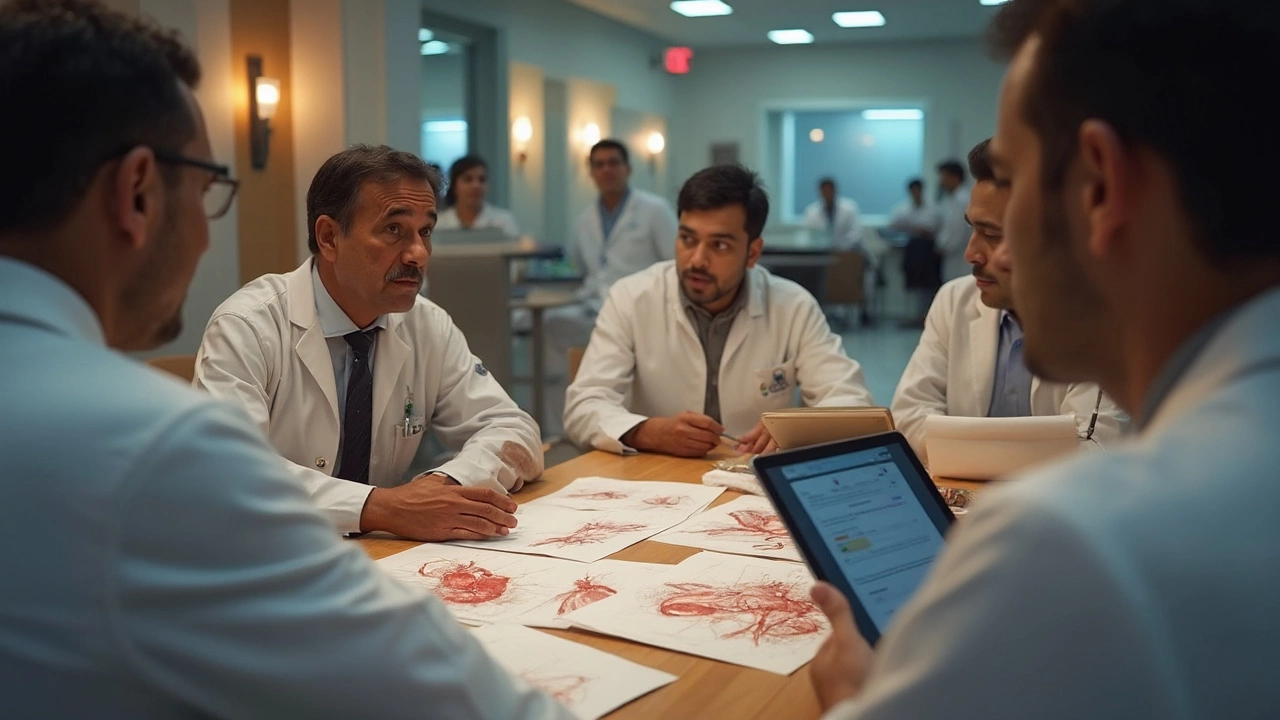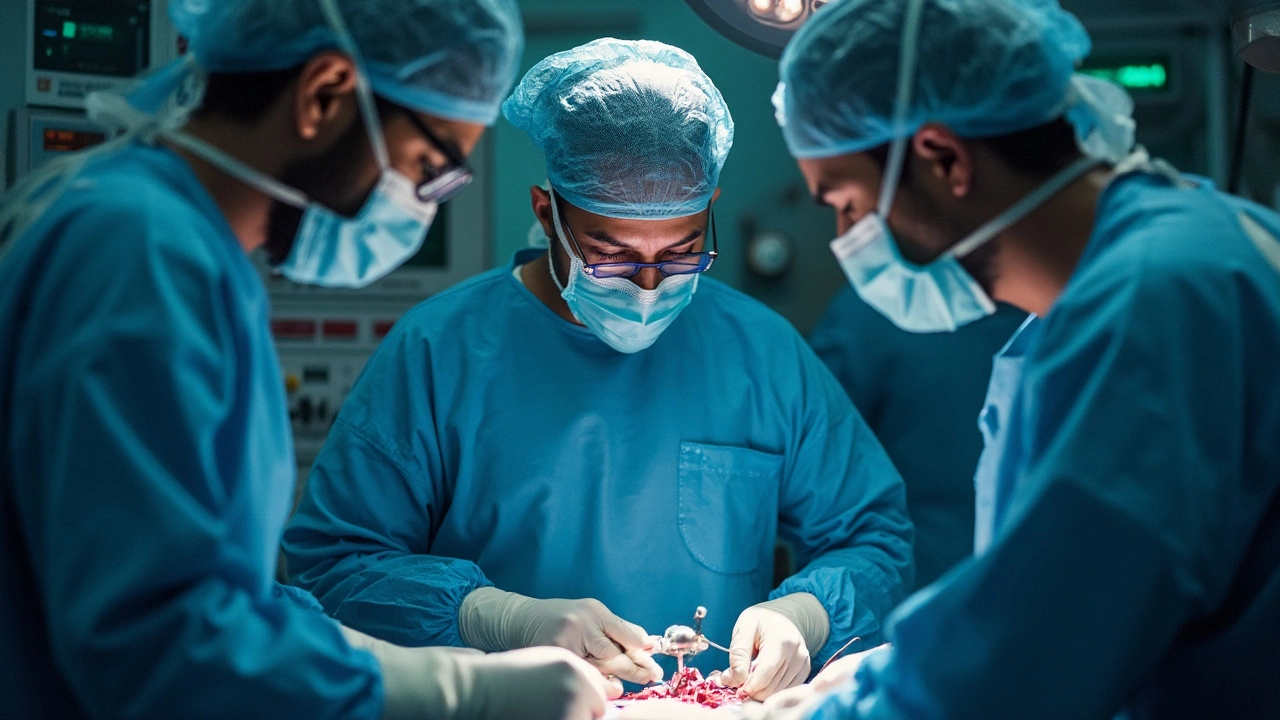Ask any heart surgeon about the toughest operation they've ever performed, and you'll probably see them pause, weighing memories of split-second decisions, intense mental focus, and sheer fatigue. It’s not just about stitching arteries or replacing valves. Some heart surgeries are like a high-speed chess match, and a single wrong move can change everything. Even the most seasoned surgeons admit their hands shake a bit before certain procedures. The heart’s unforgiving — and so is the pressure when a life is on the table.
What Makes a Heart Surgery the "Hardest"?
There’s no easy checklist. Hardest means different things to different cardiologists. Some judge by survival rates; others by the pure number of tasks you juggle at once. But among the hall-of-famers for difficulty, two procedures stand out: heart transplantation and the arterial switch operation for transposition of the great arteries, with the heart-lung transplant often considered the summit.
Why do doctors dread these? One word: complexity. Take the heart-lung transplant. You’re not just dealing with a single organ; you’re swapping out someone’s heart and lungs as one functional unit. Every vessel, every nerve — it all needs to hook up perfectly for survival. One famous study from Johns Hopkins showed these surgeries can average more than 8 hours, involve up to 25 liters of transfused blood, and sometimes need over 50 medical staff on standby. Compare that to a typical open-heart bypass, which lasts about 3-5 hours and is way less of a logistical nightmare.
The longer the surgery, the more exhausted everyone gets. Fatigue creeps in. Mistakes become easier to make. Managing someone’s body temperature, making sure each stitch is airtight, and keeping blood flowing to the brain — the margin for error is razor thin. No room for autopilot. Surgeons have described it as “running a marathon while solving a Rubik’s cube blindfolded.”
And the emotional grind? Off the charts. There’s no undo button. The families outside the operating room are counting on you. One misstep, and dreams dissolve in a heartbeat. When surveyed, 74% of cardiothoracic surgeons said it’s this psychological weight that keeps them up the night before a major transplant, more than even the technical stuff.
Here’s a quick comparison of common heart surgeries and their risk factors:
| Procedure | Average Duration (Hours) | Major Risks | 1-Year Survival Rate |
|---|---|---|---|
| Coronary Bypass (CABG) | 3-5 | Bleeding, stroke, infection | 93% |
| Valve Replacement | 2-4 | Blood clots, bleeding, arrhythmia | 92% |
| Heart Transplant | 4-8 | Rejection, infection, bleeding | 85% |
| Heart-Lung Transplant | 8-12 | Rejection, organ failure, infection | 68% |
| Arterial Switch (Pediatrics) | 6-8 | Arrhythmia, leakage, infection | 90% |
In India, where resources and organ donation are more limited, heart transplants and arterial switch operations present even bigger mountains. Sometimes, a surgery can get pushed hours just because the donated organ was delayed in traffic. I've watched surgeons in Bengaluru who’ve stayed awake for 40 straight hours — prepping, waiting, and operating. Try keeping your hands steady after that.

Not Just Hands: The Brainwork Behind Complex Heart Surgeries
People love to talk about a surgeon’s steady hand, but let’s be real. It’s the brain load that truly makes these operations brutal. No other field demands the fine-tuned attention to detail like cardiac surgery. One slip, and you’re not just dealing with a messy scene — you could set off a chain reaction with no fix.
A heart-lung transplant means managing the plumbing of two different organs at once. Everything’s on life support. The heart-lung machine keeps the blood moving outside the body, but here’s something most people don’t know — the moment you stop the machine and try to get the heart beating on its own, the tension in the theatre is thick enough to cut. No matter how many times you’ve done it, that’s always a moment of silent prayers.
Let’s talk arterial switch — mainly for babies born with their major arteries reversed. The heart is thumbnail-sized. You have to cut, shift, and reattach tubes as thin as a ballpoint pen, without letting them leak or kink. For a grown-up, that’s hard; for a newborn, it’s horrifying. More than half the kids need multiple follow-ups, and even after a perfect surgery, there’s a chance the arteries could grow crooked or narrow. That means some surgeons actually train by stitching paper under microscopes, prepping their muscles for hours of delicate wrist work.
Surgeries also move fast. Cardiac teams work like pit crews. I’ve watched in disbelief as instruments get passed at Formula 1 speeds. But it’s not all skill — it’s relentless science. Every heartbeat is logged. Vitals get checked on six different monitors. Even in the middle of the night, someone’s always on alert for a blip on the screen.
Here are some decision-making dilemmas surgeons face during long, hard surgeries:
- When to restart the heart-lung machine if blood pressure plummets?
- Should you use a graft from the leg or a synthetic material to patch a vital vessel?
- What to do if the new heart beats out of sync with the patient’s existing electrical system?
- How to handle clotting that won’t stop, even with standard medications?
And that’s just a tiny fraction. It all comes back to thinking fast, trusting your team, and, honestly, a bit of old-school instinct. There are moments where technology fails, and it’s just a hunch or a memory from some dusty old textbook. That’s the difference between an excellent surgeon and a legendary one.
hardest surgery in cardiology? Look at the stats, but also listen to the whispers in the hospital corridors. Stories about surgeons who scrub out with trembling hands after 10-hour surgeries — not out of fatigue, but pure emotional relief that their patient made it through.

Tips, Solid Facts, and Myths Busted for Difficult Cardiac Surgeries
If you or someone you love ever faces one of these surgeries, you want facts, not cookie-cutter tips. First, know this: hospitals that perform more of these complex procedures almost always have better outcomes. It’s not about five-star facilities; it’s about team experience. A 2023 study in Mumbai found survival rates after a heart-lung transplant doubled in high-volume centers, mainly because the team isn’t flustered by surprises.
Myth: Only old people need big heart surgeries. Nope. Babies, kids, teens — some of the hardest surgeries are done before their first birthday. And young patients bounce back way faster, so aggressive treatment is often the best bet.
Another tip: Ask about the backup plan. The best surgical teams aren’t just hoping things go right; they have plans B, C, and D lined up. Some hospitals in Bengaluru even have a second heart or lung on ice, just in case the first graft isn’t viable. It sounds wild, but when every minute counts, it’s the difference between a miracle and a tragedy.
Food for thought: technology can only do so much. Robotic assistance and 3D printing have made certain steps easier, but the wildest, most daring steps are all manual. A robot can’t feel if a suture is just right or react to a sudden bleed.
Here’s what you can do to help if you’re prepping for, or supporting someone through, a major heart surgery:
- Choose a cardiothoracic center with a solid track record in the specific surgery needed — not just any heart hospital.
- Meet the team, not just the main surgeon. Nurses, anesthetists, support staff all matter.
- Don’t be shy about asking about their experience, infection rates, and plans for emergencies. The best doctors expect these questions.
- Consider a second opinion, especially if the operation is rare or high-risk. Even top doctors talk to peers before going in.
- Watch for warning signs after surgery: fever, chest pain, sudden weakness. Don’t wait it out; every hour counts if something is wrong post-op.
Quick reality check — even after a perfect operation, the road to recovery is long. Physical stamina can take months to return. Emotional scars linger longer. No shame in seeing a counselor or therapist after major surgery; many people underestimate the mental fallout of simply surviving.
Cardiothoracic surgery is never just science classes and textbooks. It’s midnight emergencies, families holding hands outside sterile doors, surgeons gulping coffee just to stay sharp. You can read every stat and tip out there, but what really matters is trust: in the skill of the team and your own fighting spirit.

 What’s Taking Over from Metformin in Diabetes Care?
What’s Taking Over from Metformin in Diabetes Care?
 Herbs That Harm Your Kidneys: What to Avoid for Better Kidney Health
Herbs That Harm Your Kidneys: What to Avoid for Better Kidney Health
 Calorie Needs for a 55‑Year‑Old Woman to Lose Weight
Calorie Needs for a 55‑Year‑Old Woman to Lose Weight
 Kelly Clarkson's Rapid Weight Loss Journey: Secrets and Tips
Kelly Clarkson's Rapid Weight Loss Journey: Secrets and Tips
 When is Cancer Beyond Cure?
When is Cancer Beyond Cure?